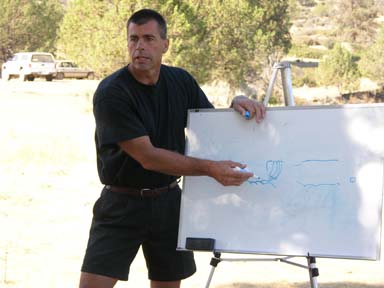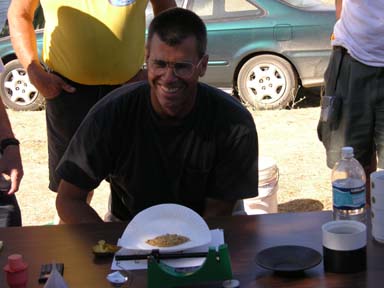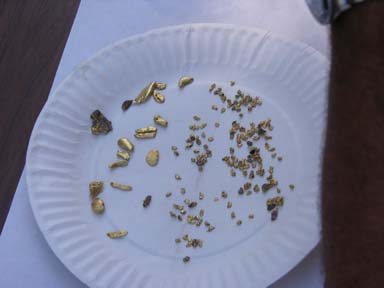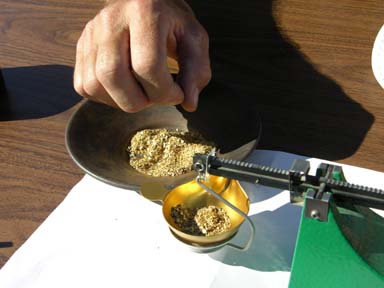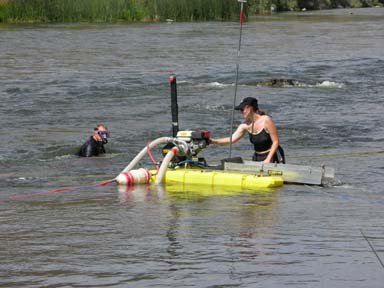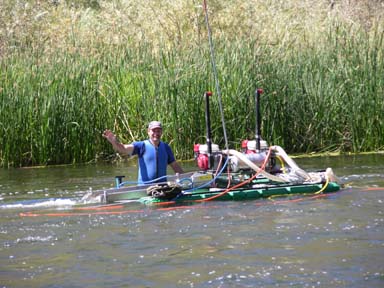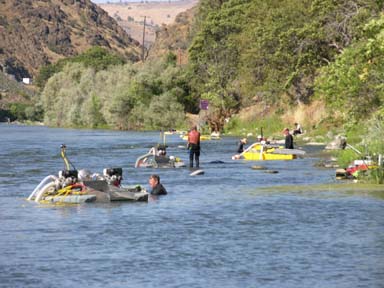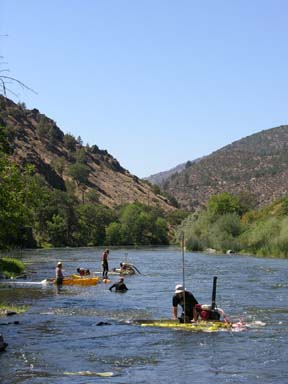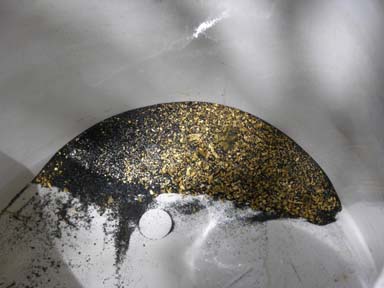Joint Venture Agreement
THIS JOINT VENTURE AGREEMENT (the “Agreement”) made and entered into this ____ day of _____________, between The New 49’ers, Incorporated, 27 Davis Road, Happy Camp, CA 96039 (The New 49’ers), and the following person:Name: _________________________________________________________________
Address/ Phone: _________________________________________________________
______________________________________________________Phone:________________
hereinafter individually referred to as Participant(s) (“Participant(s)”) of the Joint Venture, having signed this Agreement prior to the Joint Venture taking effect. Numerous other persons may be included in this Joint Venture, each of whom will sign a copy of this Agreement. The other Participants of the Joint Venture are identified on the list attached hereto as Exhibit “A.”
BACKGROUND:
A. The Participants wish to enter into an association of mutual benefit to jointly invest into and operate a small-scale mining Project.
B. The terms and conditions of this Agreement set out the terms and conditions governing this association.
IN CONSIDERATION OF and as a condition of the Participants entering into this Agreement and other valuable consideration, the receipt and sufficiency of which is acknowledged, the parties to this Agreement agree as follows:
Formation
By this Agreement, the Participants enter into a Joint Venture (“Joint Venture”) in accordance with the laws of the State of California. The rights and obligations of the Participants will be as stated in the applicable laws of the State of California pertaining to Joint Ventures except as otherwise provided in this Agreement.
Name
The business name of the Joint Venture will be the ___________________, Group Mining Venture
Purpose
The exclusive purpose of the Joint Venture will be to locate and develop one or more high-grade gold deposits (the “Project”) on unpatented mining claims or private property where The New 49’ers are allowed a license to mine.
Term
4. The Joint Venture will begin on _________________, and will continue to be effective and in full force for one week or until terminated as provided in this Agreement.
Place of Business
5. The principal office and legal address of the business of the Joint Venture will be located at 27 Davis Road, Happy Camp, CA 96039.
Management
6. The Participants each agree that Dave McCracken is an agent of The New 49’ers, assigned as the General Manager of the Joint Venture. It is agreed that the General Manager will provide services to the Joint Venture including mining expertise, local knowledge and leadership, and shall have the authority to make all final decisions about how the Project and associated activity will be conducted.
Capital Contributions
7. Each of the Participants shall contribute to the capital of the Joint Venture, in cash, or other negotiable instruments (funds), real property or experienced-assistance in the Project in
agreed-upon value, as determined by the General Manager.
Utilization of Capital Contribution Funds
8. Capital contribution funds shall be used by the General Manager to pay costs associated with the Joint Venture. There will be no return to Participants of funds from capital contributions that are in excess of costs associated with the Joint Venture once the Joint Venture is completed. Any such excess funds will be retained by the General Manager to be his property as compensation for his services to the Joint Venture.
9. Because the General Manager is not a Participant of the Joint Venture, he will not receive a share of the recovered gold, but instead will receive compensation for his services as set forth in paragraph 8, above.
Distribution of Recovered Gold
10. All recovered gold from the Project will be split evenly amongst the Participants on the final day of the Project, except as provided in paragraph 19, below.
11. If larger-sized gold nuggets are recovered that cannot be split up evenly, by majority vote, the Participants will devise an equitable means to distribute the larger pieces of gold.
12. No representation or guarantees are made by The New 49’ers or the General Manager to any Participant about how much gold will be recovered during the Project.
Tax Consequences
13. No gold will be sold during the duration of the Joint Venture. Therefore, there will be no financial income for the Joint Venture. The Joint Venture does not intend to file any tax returns or any reporting forms.
14. If there are any tax consequences from the share of gold received by a Participant, or a Participant’s sale of such gold, it will be the full responsibility of the individual Participant to file returns with the appropriate authorities as necessary or required by law.
Withdrawal of Capital
15. No Participant will have the right to demand or withdraw any portion of their capital contribution without the express written consent of the General Manager.
General Manager’s Duties
16. Duties and obligations of the General Manager in relation to the Joint Venture will include the following:
a. Establishing policy with regard to achieving the purpose and objectives of the Joint Venture;
b. Managing the day to day business of the Joint Venture;
c. Monitoring, controlling and directing the financial, business and operational affairs of the Joint Venture;
d. Monitoring, analyzing and acting on all issues over which the General Manager will have express or implied authority according to this Agreement;
e. Accepting all responsibilities involved with hiring of and payments to third party contractors; and,/
f. Utilize his mining experience, knowledge and leadership to assist Participants in their attempt to locate and develop one or more high grade gold deposits.
Admitting a New Participant
17. New Participants may be admitted into the Joint Venture only with the written approval of the General Manager. Any new Participant will agree to be bound by all the covenants, terms, and conditions of this Agreement. Any new Participant will receive an equal interest in the Joint Venture, providing the other provisions of this Agreement are met.
Disassociation of a Participant
18. If, during the course of the Project, the Participant becomes physically unable to participate in the Project, and/or it is determined in the sole discretion of the General Manager that Participant is not qualified to participate in the Project, and the Participant therefore is asked by the General Manager to depart the Project before the week-long term of the Project is completed, Participant will be entitled to receive a pro-rated refund of his or her capital investment in the Project for those days remaining in the term of the Project.
19. If a Participant does not actively participate for the complete duration of the Project, he or she is only entitled to a pro rata share of the gold that has been recovered by the date of his or her departure. That share will be calculated at the end of the project by dividing a full share of the gold by the number of days the (ex)Participant participated, allowing a 1/7th share for each day of active participation.
Liquidation
20. The Joint Venture will be dissolved immediately upon completion of the Project or as others agreed to by the General Manager and a majority of the Participants.
Transfer of Venture Interest
21. A Participant will not in any way transfer or otherwise alienate his or her interest in the Venture or its assets. Any such prohibited transfer or alienation, if attempted, will be void and without force or effect.
Insurance
22. Participant agrees to either attach a copy of his or her personal active accident insurance policy to this agreement, or purchase the $5,000 Group Accident Policy that is offered by The New 49’ers.
Indemnification
23. Participant acknowledges and understands that most of the Project activities will take place outdoors in the national forest, along mountain streams and rivers, in natural settings that require safety to be a personal matter, primarily judged by where each Participant feels he or she can go, or what he and she can do, without compromising the safety of the Participant or other persons who are present.
24. Participant acknowledges and understands that in the event of an accident or health-event that may require special medical care, such care could be delayed because of the remoteness of the location where the Project is taking place. Participant agrees that participation in prospecting, diving, boating or other outdoor activities can be potentially dangerous, and is making an informed personal choice to accept such risks in return for the benefits to be gained by participating in the Joint Venture.
Participant pledges that he or she will use good judgment to not place him or herself, or others, in danger. Participant certifies that he or she is qualified from past personal experience to make sound judgment in these matters of outdoor safety.
25. Participant promises to keep the General Manager or his assistants fully informed at all times of any and all personal limitations that will affect the activity, so that Participant is not required to perform tasks that he or she considers dangerous or risky to Participant or others. Regardless of what Participant is asked to do, he or she agrees to refuse to perform any tasks that Participant does not feel comfortable performing safely.
26. Participant personally assumes full responsibility for any injury, loss or liability, including but not limited to, loss of life, limb, health, employment and/or sight, which may result, or be alleged to have resulted, from Participant’s, or Participant’s spouse’s, children’s, or guest’s participation in the Project and/or other activities related to the Joint Venture on New 49’ers properties, including New 49’ers mining claims. In the event of Participant’s injury, loss or liability, the Participant agrees to hold harmless the other Participants, the General Manager and/or his assistants, The New 49’ers, Inc. and its owners, supervisors, managers, employees and/or agents, from and against any and all actions, claims, demands, liability, loss, damage and/or expense of any kind, including attorney’s fees, arising from any such claims.
Liability
27. Participant will not be liable to the Joint Venture or to any other Participant for any negligence resulting from an error in judgment or any act of or failure to act by Participant where made in good faith. The Participant will be liable only for acts or failures to act resulting from gross negligence or willful misconduct.
28. This Joint Venture is limited only to the activity and time-period of the Project. Participant does not have any authority to incur expenses or commit any other Participant to any obligations or liabilities that are not outlined within this Agreement.
Participant’s Duties
29. Participant will use his or her best efforts, fairly and in good faith to facilitate the success of the Joint Venture. Participant shall declare all the gold he or she recovers daily to the General Manager and the other Participant.
Agreement to Arbitrate
30. This Agreement shall be deemed to have been entered into in the State of California. In the event of any controversy, dispute or claim relating in any way to the performance or breach of the Agreement shall be finally determined, at the request of any party to this Agreement, by binding arbitration conducted in Siskiyou County, California, in accordance with the then existing rules of the American Arbitration Association, and judgment upon any award rendered by the arbitrator may be entered by the Superior Court of Siskiyou County, State of California. The parties intend that this Agreement to arbitrate be valid, enforceable, and irrevocable.
Jurisdiction
31. Participants and The New 49’ers submit to the jurisdiction of the Superior Court of Siskiyou County, State of California for the enforcement of this Agreement or any arbitration award or decision arising from this Agreement.
Miscellaneous
32. This Agreement contains the entire agreement between the parties. All negotiations and understandings have been included in this Agreement. Statements or representations which may have been made by any party to this Agreement in the negotiation stages of this Agreement may in some way be inconsistent with this final written Agreement. All such statements are declared to be of no value in this Agreement. Only the written terms of this Agreement will bind the parties.
33. This Agreement and the terms and conditions contained in this Agreement apply to and are binding upon the Participant’s successors, assigns, executors, administrators, beneficiaries, and representatives.
34. Any notices or delivery required here will be deemed completed when hand-delivered, delivered by agent, or seven (7) days after being placed in the post, postage prepaid, to the parties at the addresses contained in this Agreement and the attached list of other Participants or as the parties may later designate in writing.
35. Unless expressly provided to the contrary in this Agreement, each and every one of the rights, remedies and benefits provided by this Agreement will be cumulative and will not be exclusive of any other such rights, remedies and benefits allowed by law.
IN WITNESS WHEREOF the Participant has duly affixed his or her signature on this
___________ day of __________________________,
PARTICIPANT________________________________________
WITNESS____________________________________________
THE NEW 49’ERS
By: _____________________________________
Dave McCracken, General Manager



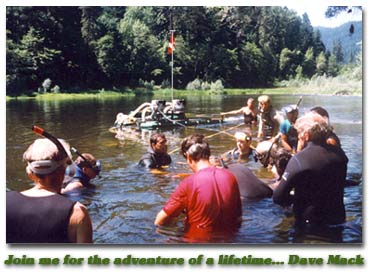

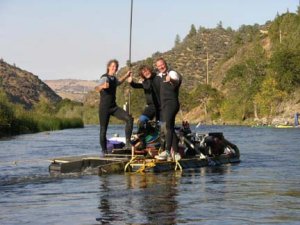
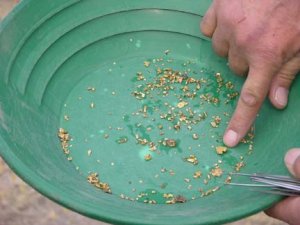
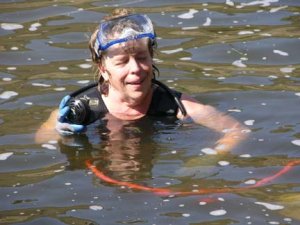 It is also true that a beginner who is worried about drowning in the river does
It is also true that a beginner who is worried about drowning in the river does 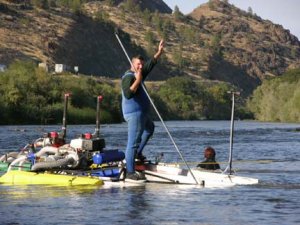
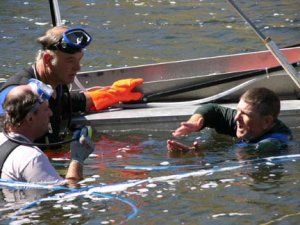
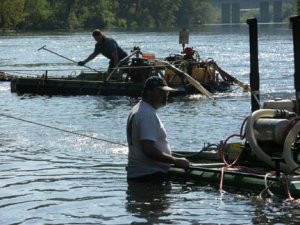
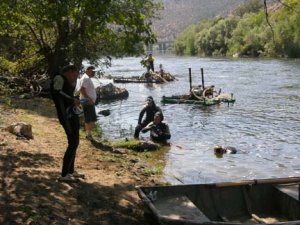
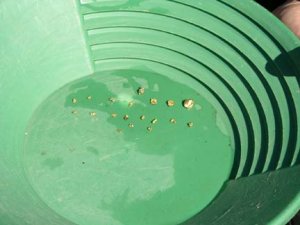
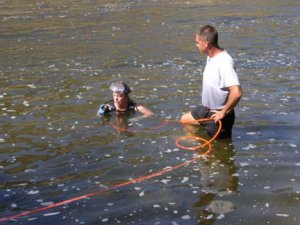
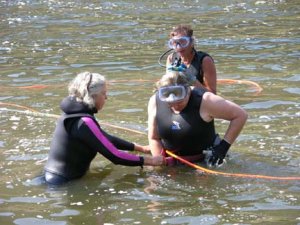
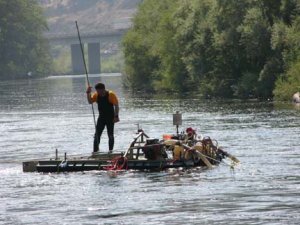
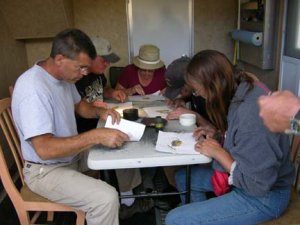
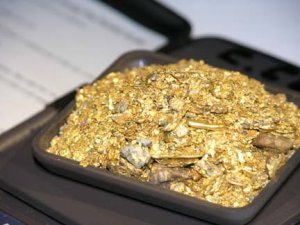
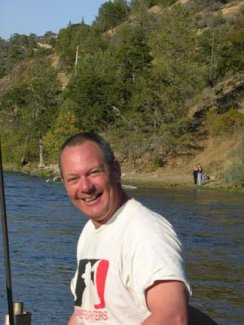 “Dave Beatson from New Zealand”
“Dave Beatson from New Zealand”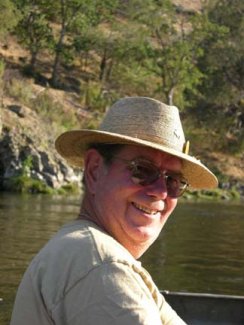 looks to him to provide all of the important basic necessities, whether it is a cup of coffee in the morning, fuel to keep the dredges operating, a spare part, a Band-Aid, or even a spanking if you deserve one. I’m not talking about anything kinky here. Otto has a kind way of telling a person to quit being a sissy just at the time you need to hear it! He adds much-needed life and substance to these projects that make them better for everyone.
looks to him to provide all of the important basic necessities, whether it is a cup of coffee in the morning, fuel to keep the dredges operating, a spare part, a Band-Aid, or even a spanking if you deserve one. I’m not talking about anything kinky here. Otto has a kind way of telling a person to quit being a sissy just at the time you need to hear it! He adds much-needed life and substance to these projects that make them better for everyone.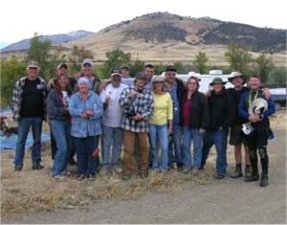
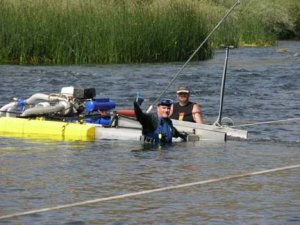

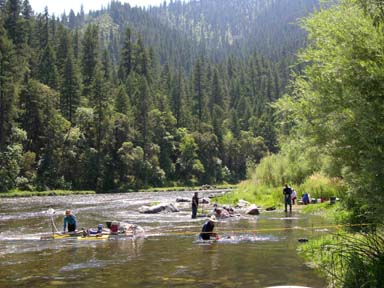
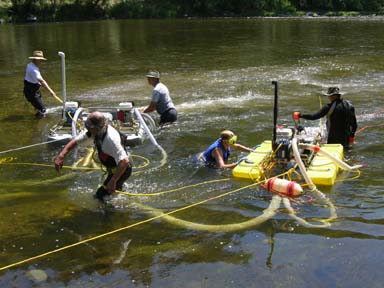
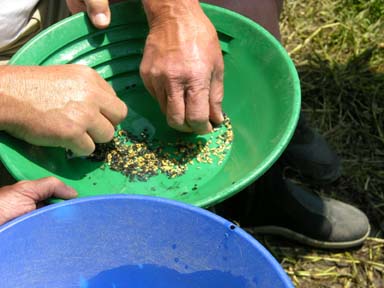
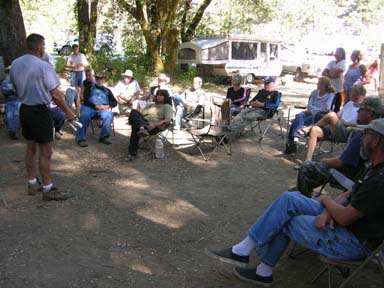 The first thing we do is set up a camping area where we can have our planning sessions each morning.
The first thing we do is set up a camping area where we can have our planning sessions each morning.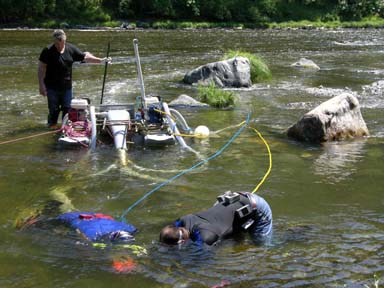
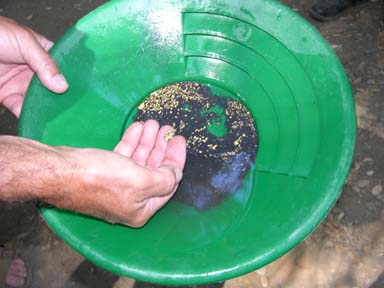
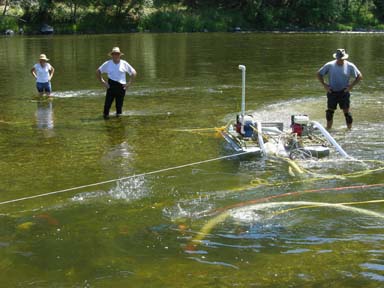 This was a very easy location where beginners could learn!
This was a very easy location where beginners could learn!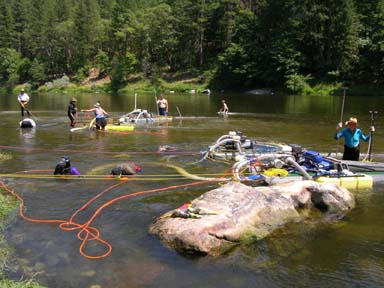 The 6-inch dredge was drifted across the river to dredge some samples on the other side. This, because some members had reported several years ago that they were finding nice gold over there mixed with pieces of metal from some kind of old Chinese camp. This all took place at the top end of K-15A. But we were not able to find hard-pack streambed on the far side of the river, and did not want to invest very much time over there since we were doing so well on the road-side. One hard effort was made to dredge a sample in the middle of the river, but we gave up when the loose streambed material reached around 6 feet deep.
The 6-inch dredge was drifted across the river to dredge some samples on the other side. This, because some members had reported several years ago that they were finding nice gold over there mixed with pieces of metal from some kind of old Chinese camp. This all took place at the top end of K-15A. But we were not able to find hard-pack streambed on the far side of the river, and did not want to invest very much time over there since we were doing so well on the road-side. One hard effort was made to dredge a sample in the middle of the river, but we gave up when the loose streambed material reached around 6 feet deep.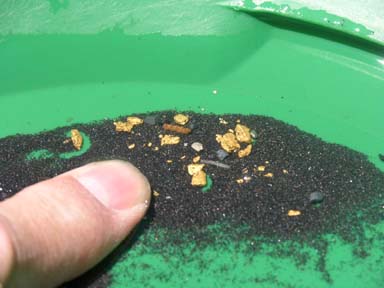
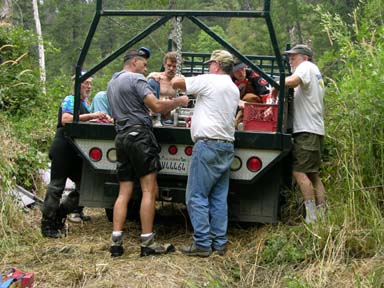
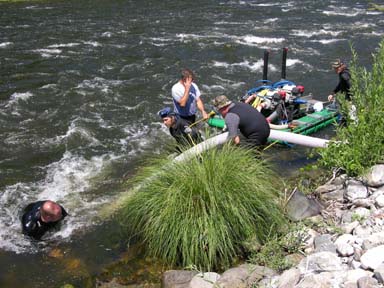
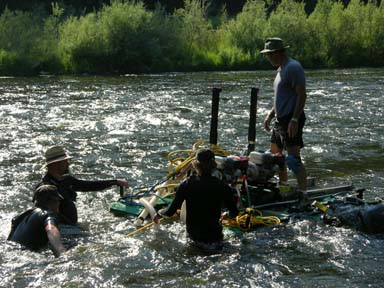
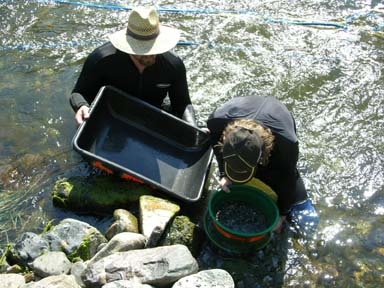
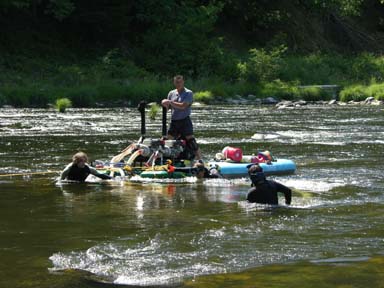
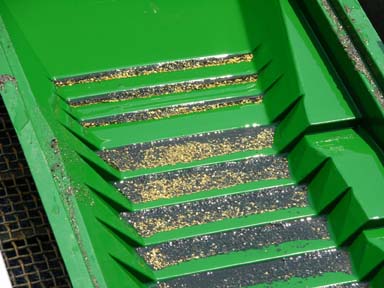
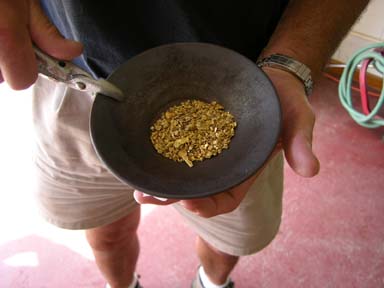

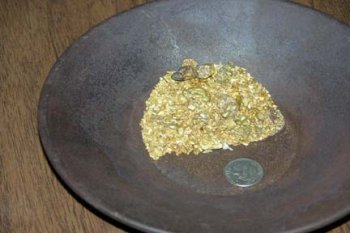
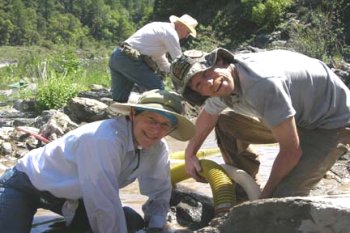
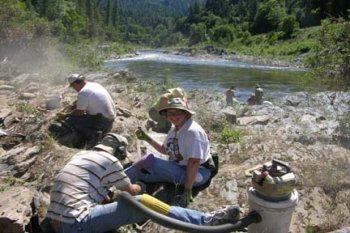 As we had a fair number of participants in this Project, we decided to split into two teams on the first day. I went to a lower portion of this claim along with everyone who had
As we had a fair number of participants in this Project, we decided to split into two teams on the first day. I went to a lower portion of this claim along with everyone who had 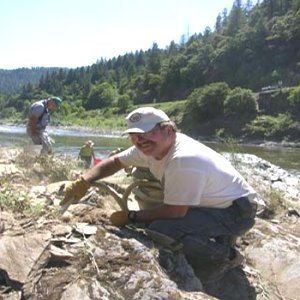 So it did not take us long to organize ourselves into a production team. Several participants were digging material out of the gold traps in the bedrock. Several others were following closely behind, using their vack machines to suck all of the remaining pay-dirt from the gold traps in the bedrock. The pay-dirt was carried in buckets over to several more participants that were screening everything into plastic washtubs. The screened material was then being fed into a
So it did not take us long to organize ourselves into a production team. Several participants were digging material out of the gold traps in the bedrock. Several others were following closely behind, using their vack machines to suck all of the remaining pay-dirt from the gold traps in the bedrock. The pay-dirt was carried in buckets over to several more participants that were screening everything into plastic washtubs. The screened material was then being fed into a 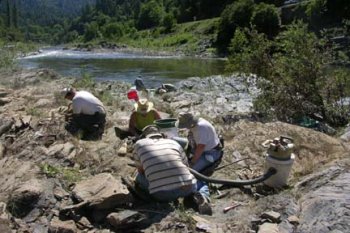
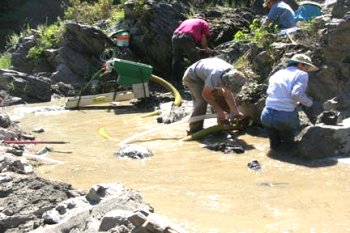 Through just a little sampling, Craig’s team quickly discovered that the hard-pack was still present right where we left off last year. We were amazed that nobody had returned there, since we did so well! This was a great area to develop further, because the natural contours of the bedrock create small pools of water, allowing us to set up a
Through just a little sampling, Craig’s team quickly discovered that the hard-pack was still present right where we left off last year. We were amazed that nobody had returned there, since we did so well! This was a great area to develop further, because the natural contours of the bedrock create small pools of water, allowing us to set up a 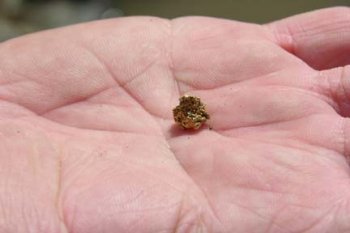 As the guys on my team were feeling really good about all the gold they were recovering in their vack-mining program, we continued into the next two days working out exposed cracks and crevices in the exposed bedrock, while watching an ever-increasing amount of gold accumulate in the Le’Trap sluice. We were doing really well!
As the guys on my team were feeling really good about all the gold they were recovering in their vack-mining program, we continued into the next two days working out exposed cracks and crevices in the exposed bedrock, while watching an ever-increasing amount of gold accumulate in the Le’Trap sluice. We were doing really well!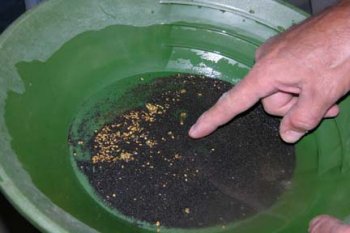 It is always an incredible feeling of fortune when you discover something rich. The best way I can describe it is the feeling you might experience if you hit the bonanza when playing a slot machine and the money just keeps pouring out of the machine onto the floor. But finding a rich gold deposit is better, because you are recovering beautiful, natural gold; Mother Nature’s purest of treasures! The first realization of a rich gold discovery brings out an exhilarated enthusiasm from you that few other things in life can match.
It is always an incredible feeling of fortune when you discover something rich. The best way I can describe it is the feeling you might experience if you hit the bonanza when playing a slot machine and the money just keeps pouring out of the machine onto the floor. But finding a rich gold deposit is better, because you are recovering beautiful, natural gold; Mother Nature’s purest of treasures! The first realization of a rich gold discovery brings out an exhilarated enthusiasm from you that few other things in life can match.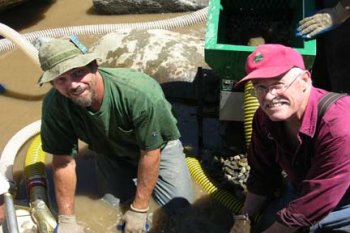 It did not take us long to set up a second high-banker on the fifth day of the project, and we were no longer two separate teams. There is a point on all of these Projects where everyone comes together as a unified group. Part of it comes from the hard work we do together. Part comes from the excitement of making a rich discovery. And part comes from the enthusiasm to work together so that we can recover as much gold as possible in the remaining time that we have. Once the team comes fully together, I usually find myself with little remaining to do as the Project manager. By this time, everyone already knows what needs to be done. There is a very worthwhile group chemistry that happens in these Projects, perhaps similar to what a competitive sports team feels when they are winning games against very challenging opponents. I always feel pride watching my team go at it, working together, laughing and feeling great about what we have accomplished together. Each Project develops its own unique chemistry; almost like something that comes alive. And I always feel a little sadness knowing that our partnership will soon end.
It did not take us long to set up a second high-banker on the fifth day of the project, and we were no longer two separate teams. There is a point on all of these Projects where everyone comes together as a unified group. Part of it comes from the hard work we do together. Part comes from the excitement of making a rich discovery. And part comes from the enthusiasm to work together so that we can recover as much gold as possible in the remaining time that we have. Once the team comes fully together, I usually find myself with little remaining to do as the Project manager. By this time, everyone already knows what needs to be done. There is a very worthwhile group chemistry that happens in these Projects, perhaps similar to what a competitive sports team feels when they are winning games against very challenging opponents. I always feel pride watching my team go at it, working together, laughing and feeling great about what we have accomplished together. Each Project develops its own unique chemistry; almost like something that comes alive. And I always feel a little sadness knowing that our partnership will soon end.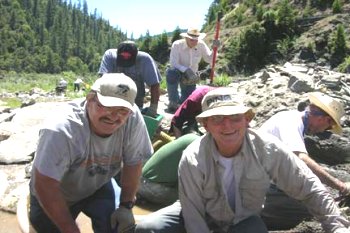
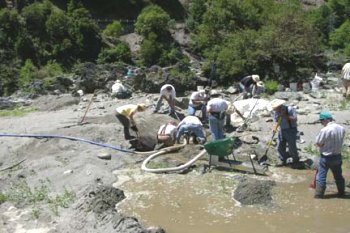
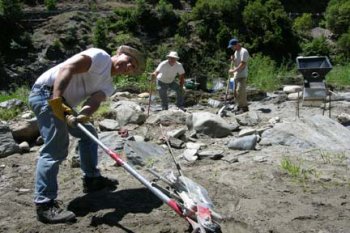

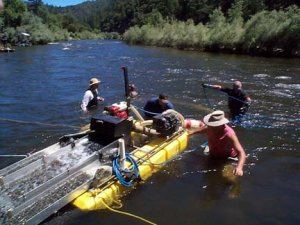
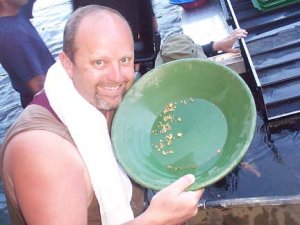
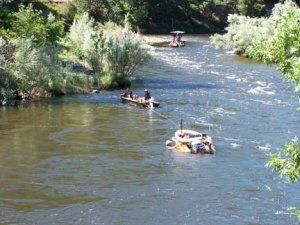 The main problem we were facing early in the week was that the Klamath River was still flowing abnormally high because of the record amounts of rain we had last winter. High (fast) water was making it nearly impossible for us to complete sample holes out in the middle of the river.
The main problem we were facing early in the week was that the Klamath River was still flowing abnormally high because of the record amounts of rain we had last winter. High (fast) water was making it nearly impossible for us to complete sample holes out in the middle of the river.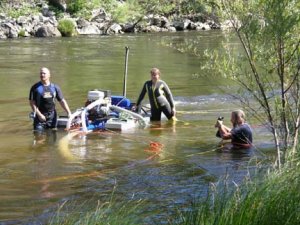 We place a lot of attention with the beginners during the first day or two of these Projects. The idea is to help them through the initial steps so that they can become more productive participants in the ongoing sampling and productive aspects of the bigger program. Beginners are graduated to more advanced work as the days go by and the sampling program evolves. All of the effort combines to a very effective mining program.
We place a lot of attention with the beginners during the first day or two of these Projects. The idea is to help them through the initial steps so that they can become more productive participants in the ongoing sampling and productive aspects of the bigger program. Beginners are graduated to more advanced work as the days go by and the sampling program evolves. All of the effort combines to a very effective mining program.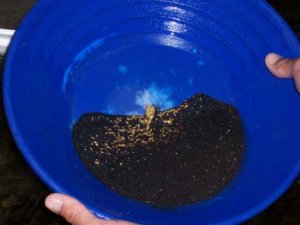
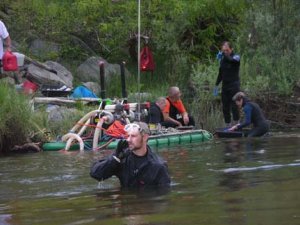
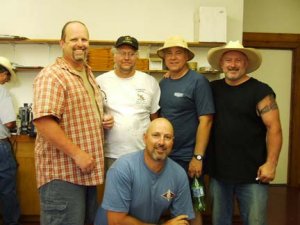 Our 4th dredge team on this Project was being managed by Rick LaRouque. Rick was joined by several other moderately-experienced dredgers. But these were some
Our 4th dredge team on this Project was being managed by Rick LaRouque. Rick was joined by several other moderately-experienced dredgers. But these were some 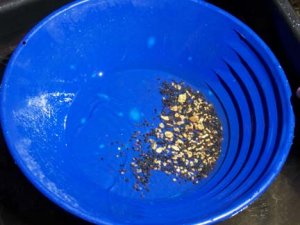
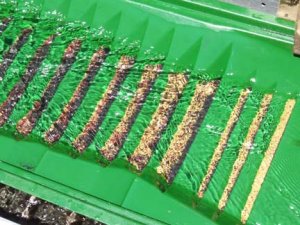 The thing about high-grade is that when you uncover it, the
The thing about high-grade is that when you uncover it, the 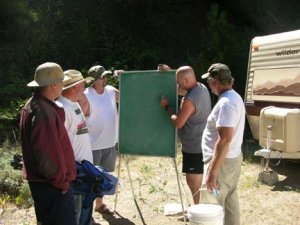 The 6th day of the Project found our whole company eager to get an early start on the river. The first thing we did was float Jake’s dredge and team downstream to fall-in alongside the A-team. It did not take very long for the teams to get both dredges into
The 6th day of the Project found our whole company eager to get an early start on the river. The first thing we did was float Jake’s dredge and team downstream to fall-in alongside the A-team. It did not take very long for the teams to get both dredges into 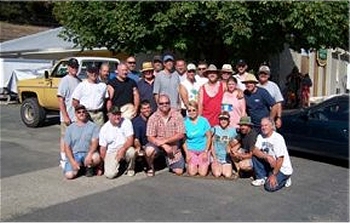 Most of these people did not even know each other only 6 days before. Yet, here they were on the river working together as an experienced team of prospectors who had overcome all of the unknowns that we began with, worked their way together through some pretty difficult conditions, kept the faith throughout the whole process, and pulled off a
Most of these people did not even know each other only 6 days before. Yet, here they were on the river working together as an experienced team of prospectors who had overcome all of the unknowns that we began with, worked their way together through some pretty difficult conditions, kept the faith throughout the whole process, and pulled off a 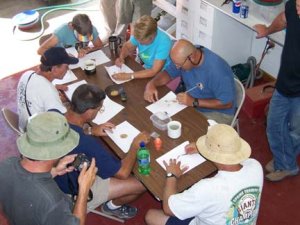
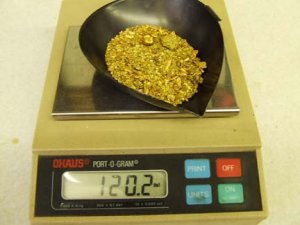

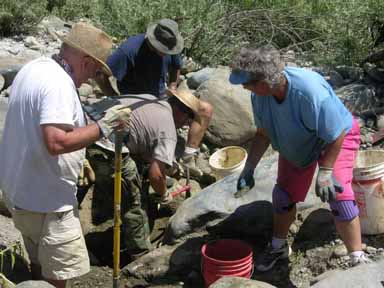
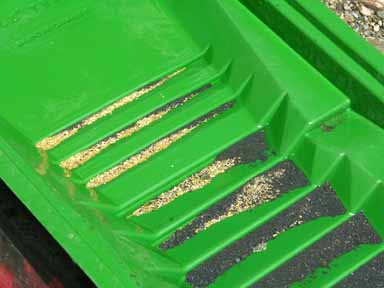
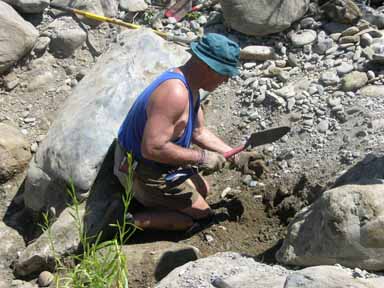 We always try and start off these high-banking Projects using gold pans to do some
We always try and start off these high-banking Projects using gold pans to do some 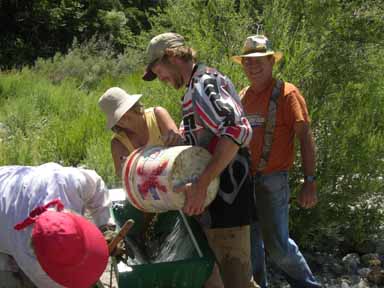 We devoted the second and third days to dialing in some team production using three separate high-bankers. Through a little trial and error, we established that the high-grade gold was located within a contact zone between two different layers of streambed, only about eight inches beneath the surface. This made for some pretty easy digging! It didn’t take us long to work out a system of filling buckets with pay-dirt to be run through one of the high-bankers.
We devoted the second and third days to dialing in some team production using three separate high-bankers. Through a little trial and error, we established that the high-grade gold was located within a contact zone between two different layers of streambed, only about eight inches beneath the surface. This made for some pretty easy digging! It didn’t take us long to work out a system of filling buckets with pay-dirt to be run through one of the high-bankers.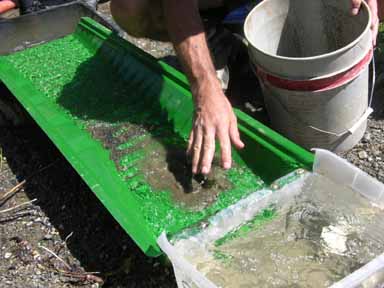
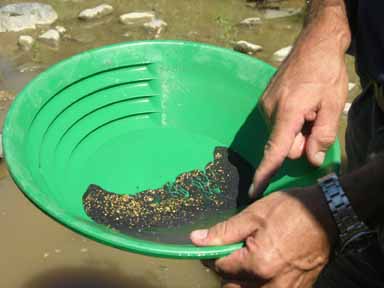
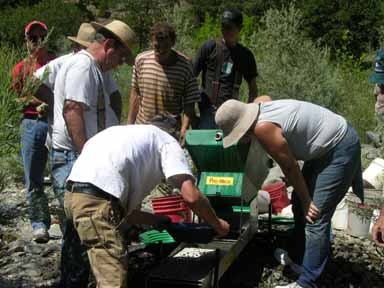 Earlier in the week, we had pulled two of the Club’s rafts out of storage in anticipation of maybe using them to do some sampling in some of the more-remote high-banking areas located on
Earlier in the week, we had pulled two of the Club’s rafts out of storage in anticipation of maybe using them to do some sampling in some of the more-remote high-banking areas located on 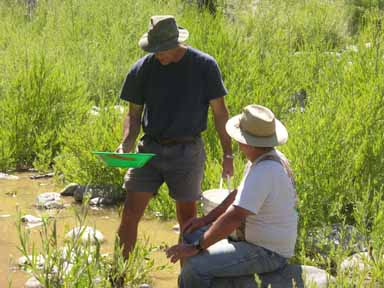
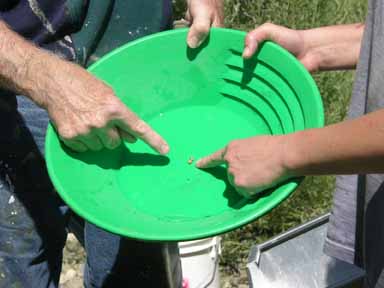
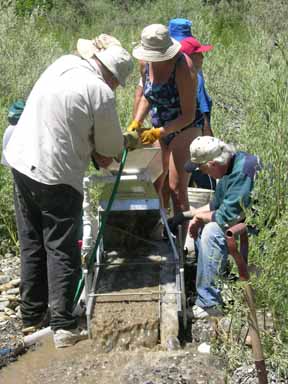
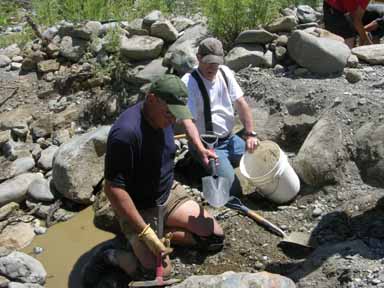
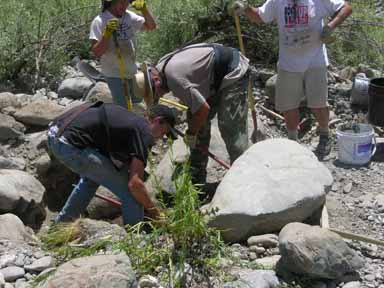
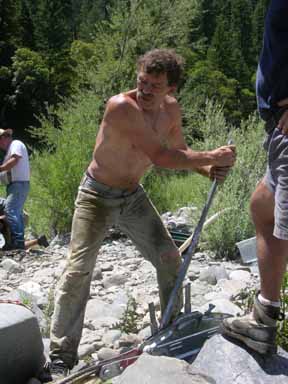
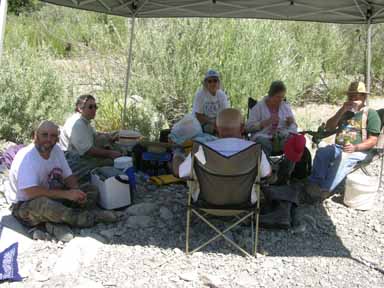
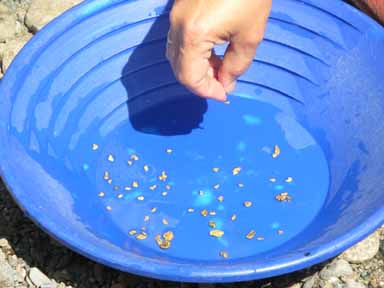 The high-banker clean-ups on the fifth day were as good as we had done all week. But we spent too much time digging in the ancient gray layer which was under the orange material. That stuff was hard and slow to dig! But it sure looked rich! Because we were spending so much time in it, we decided to have several participants do some very careful pan-sampling of the gray to see how much gold was being recovered from it. This took some doing, because it required extra care to remove every bit of the orange layer (which contained a lot of gold) off the top of the gray, without allowing any gold from above to drop down into the gray and give us a false result.
The high-banker clean-ups on the fifth day were as good as we had done all week. But we spent too much time digging in the ancient gray layer which was under the orange material. That stuff was hard and slow to dig! But it sure looked rich! Because we were spending so much time in it, we decided to have several participants do some very careful pan-sampling of the gray to see how much gold was being recovered from it. This took some doing, because it required extra care to remove every bit of the orange layer (which contained a lot of gold) off the top of the gray, without allowing any gold from above to drop down into the gray and give us a false result.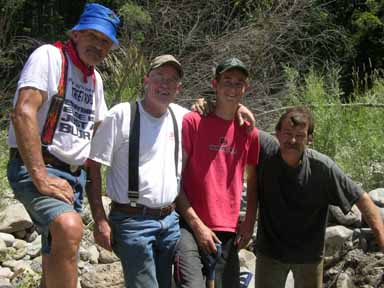 I have come to know the spirit of team camaraderie that a tight group of people experience together when we have done something extraordinary together. It is a
I have come to know the spirit of team camaraderie that a tight group of people experience together when we have done something extraordinary together. It is a 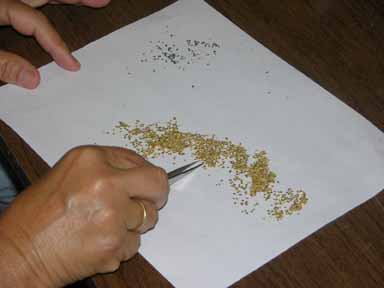
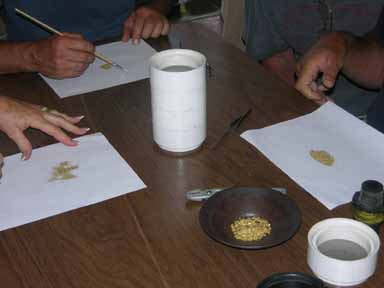
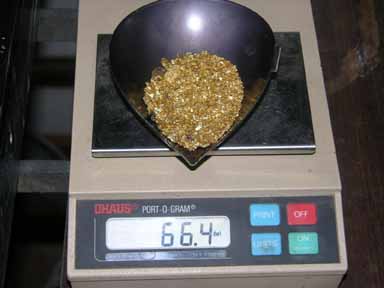 Final gold clean-up and split-off is
Final gold clean-up and split-off is 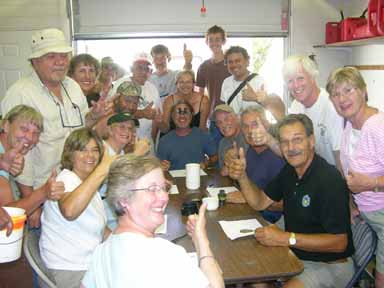
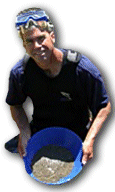
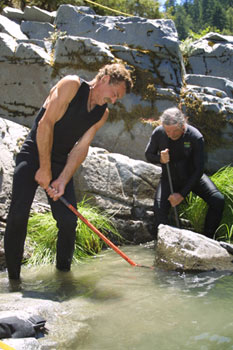
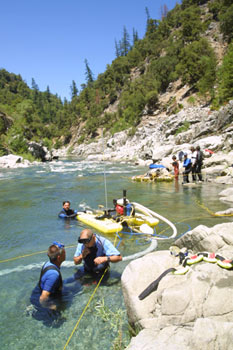
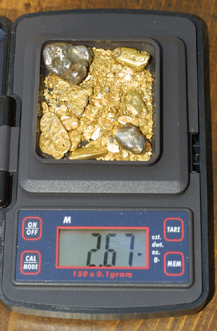
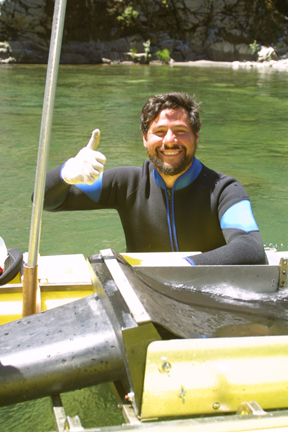
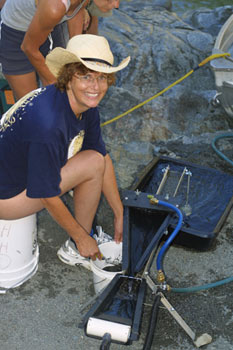
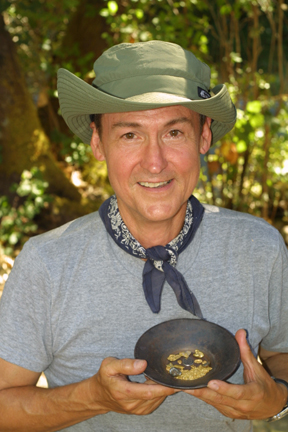
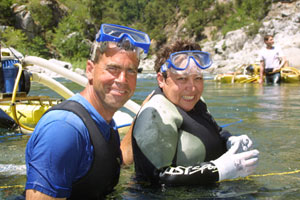
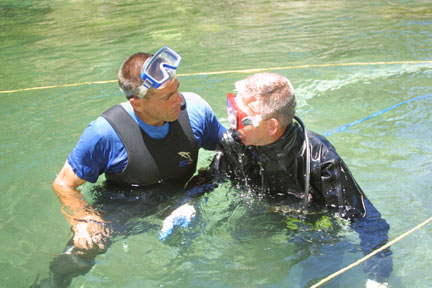
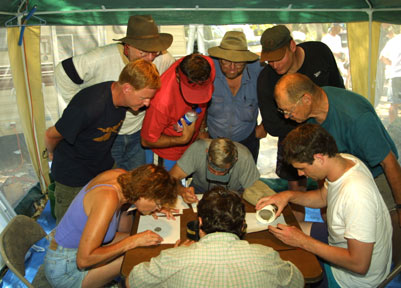
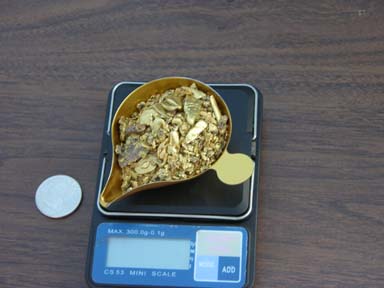
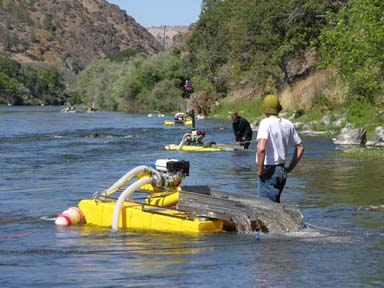
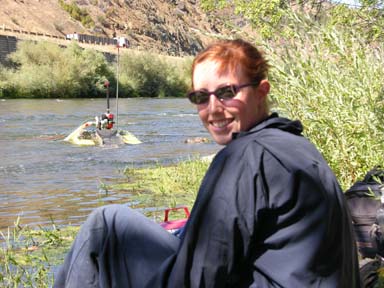 Three of the participants were
Three of the participants were 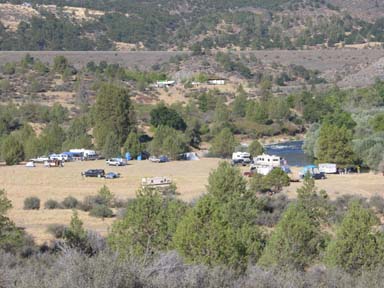
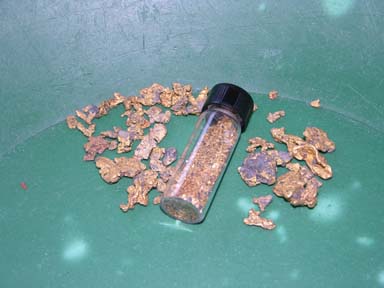
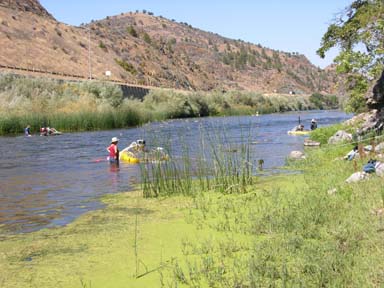
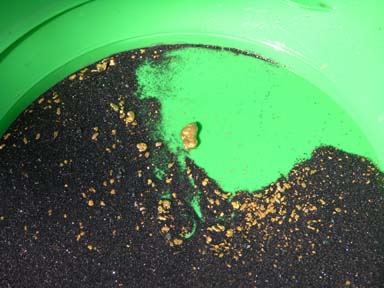
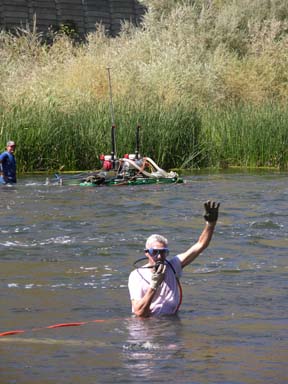 By the end of the third day, our remaining three people on the beginner-team were managing the second 4-inch dredge all by themselves, and had launched into
By the end of the third day, our remaining three people on the beginner-team were managing the second 4-inch dredge all by themselves, and had launched into 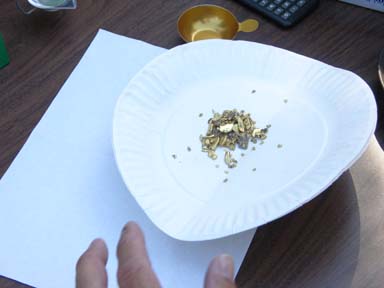
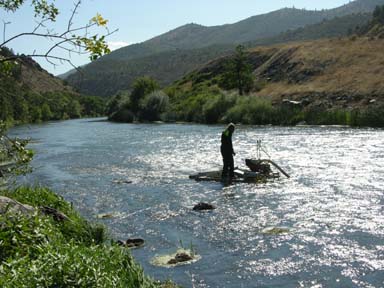 Meanwhile, Ken’s team on the other side of the river decided to dredge a hole down through the hard-pack to see if they could find bottom. They found it at a depth of around four feet in the gray-pack. With even more luck on our side, through some trial and error, they discovered that in addition to the surface gold deposit, the gray layer of hard-pack was also paying consistently in fine gold and flakes throughout the material. Then they found the largest nugget of the week on the fourth day. So they devoted the remainder of the week production-dredging to the bottom.
Meanwhile, Ken’s team on the other side of the river decided to dredge a hole down through the hard-pack to see if they could find bottom. They found it at a depth of around four feet in the gray-pack. With even more luck on our side, through some trial and error, they discovered that in addition to the surface gold deposit, the gray layer of hard-pack was also paying consistently in fine gold and flakes throughout the material. Then they found the largest nugget of the week on the fourth day. So they devoted the remainder of the week production-dredging to the bottom.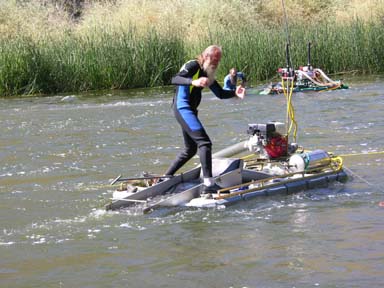 Also, it appears to me that we are attracting more experienced miners to the Projects. This increased experience helps focus the Projects in a more productive direction.
Also, it appears to me that we are attracting more experienced miners to the Projects. This increased experience helps focus the Projects in a more productive direction.